Every other day, a bottle of warm, fresh milk arrives on the river bank.
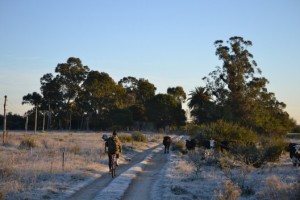 David and I live on our old wooden boat, Lista Light, you see and for the past two and half months we have been anchored in a tributary of the Rio Plate, Uruguay, training and preparing for the 5000mileproject.
David and I live on our old wooden boat, Lista Light, you see and for the past two and half months we have been anchored in a tributary of the Rio Plate, Uruguay, training and preparing for the 5000mileproject.
The milk is from our neighbours. The south of Uruguay, especially the district we live in, Colonia, is an important dairy producing region.
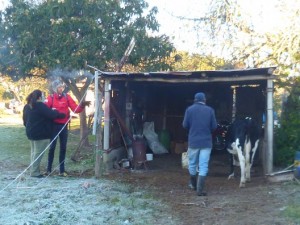 Many of the people whom we have met in Uruguay have British and Swiss ancestors and together they have introduced a taste for milk, including the production of familiar cheeses to the country.
Many of the people whom we have met in Uruguay have British and Swiss ancestors and together they have introduced a taste for milk, including the production of familiar cheeses to the country.
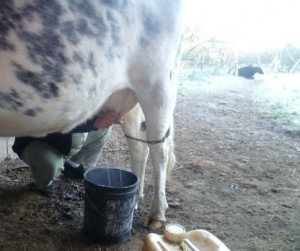 The special quality about our milk, is that we have MET the cows that produce it! One icy, early morning in June, we cycled down the track, took a right by the screeching parakeet towers (nests) and a left at the frozen “baňado” (little wetland), down the grassy path to Mercedes and Reuben.
The special quality about our milk, is that we have MET the cows that produce it! One icy, early morning in June, we cycled down the track, took a right by the screeching parakeet towers (nests) and a left at the frozen “baňado” (little wetland), down the grassy path to Mercedes and Reuben.
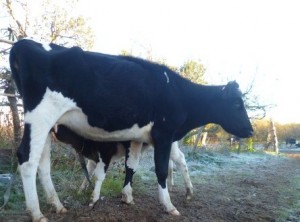 Mercedes and Reuben have a little farm or “chacra” as it is known here with: fifteen cows, ducks, geese, chickens, one cart horse, three cats and ten dogs. They milk between six and ten cows every morning, depending on the time of the year, as cows produce less milk when the grass is poor in the winter.
Mercedes and Reuben have a little farm or “chacra” as it is known here with: fifteen cows, ducks, geese, chickens, one cart horse, three cats and ten dogs. They milk between six and ten cows every morning, depending on the time of the year, as cows produce less milk when the grass is poor in the winter.
In the winter, they have a wood-burning stove in the shed to warm their hands and sterilise the bucket. One-by-one they catch the cows and bring them in to milk. Reuben or Mercedes sits on a low stool and milks the cows, gently squeezing their udders. They have different milking techniques and the cows can feel this and behave very differently to them. Cows become used to their “milk maid” and can refuse to be milked by another. Indeed, the cow David and I tried milking was not very impressed by us!
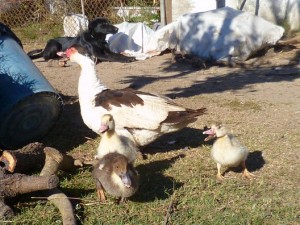 Reuben sells the milk to the neighbours. He also fills his motorbike trailer with milk containers that he sells in the local town, while Mercedes makes cheese with the surplus. The milk is raw, unlike in the UK and many countries where it is heat-treate or “pasteurised”.
Reuben sells the milk to the neighbours. He also fills his motorbike trailer with milk containers that he sells in the local town, while Mercedes makes cheese with the surplus. The milk is raw, unlike in the UK and many countries where it is heat-treate or “pasteurised”.
Mercedes and Reuben’s method of milking is no longer popular. Around the world dairy farming (like other forms/sectors of agriculture) is becoming more intensive (with greater outputs from a smaller area). This is due to many factor including:
- the agricultural revolution (use of machines, fewer larger farms, more ago-chemicals, less workers)
- increasing populations demanding more cheap milk
- companies demanding large quantities of milk to provide supermarkets and factories
- new breeds of cows producing more milk
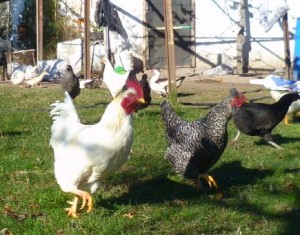 More cows are milked quicker on less land to produce more milk. Cows are milked by machines rather than people to reduce costs and time. Grassland has been improved by planting fast growing, bright green grasses; which are rich in protein, but hungry for fertilisers. These types of grasses create thick, tall, swards and are not good for wildlife. Here in Uruguay, the dairy farmland looks just like the UK’s dairy-lands (which are mainly based in the South West and North West of the England) and dairy farmland throughout the world.
More cows are milked quicker on less land to produce more milk. Cows are milked by machines rather than people to reduce costs and time. Grassland has been improved by planting fast growing, bright green grasses; which are rich in protein, but hungry for fertilisers. These types of grasses create thick, tall, swards and are not good for wildlife. Here in Uruguay, the dairy farmland looks just like the UK’s dairy-lands (which are mainly based in the South West and North West of the England) and dairy farmland throughout the world.
Reuben and Mercedes’ milk is fresh and fantastic and for us the amazing thing is that we know the cows and where they feed and are supporting local people. The pasture where the cows graze is full of birds and a mosaic of habitats from wetlands, to scrub and small woodlands, so we are supporting farming that is great for wildlife too.
QUESTIONS
Where in the world is Uruguay? Can you find us on a globe?
Apart from drinking fresh milk, how else can milk be used? (In Uruguay most of the milk produced is turned into powdered milk for and exported toVenezuela, also Brazil and Cuba).
Why is milk good for us? What nutrients does it contain?
PROJECT
Can you find out about a dairy farm near you? How do they milk the cows and how many are there? Where do they sell the milk? Do they have habitats on the farm which support wildlife too? Is the farm like Mercedes and Reuben’s farm that we visited? Or is it like the large, intensive farms that we find here in Uruguay and around the world?
LINKS
http://www.dairycouncilofca.org/Milk-Dairy/Nutrients-in-Milk.aspx
http://www.bbc.co.uk/health/treatments/healthy_living/nutrition/healthy_dairy.shtml
http://www.bbc.co.uk/iplayer/episode/b00s1np5/On_Your_Farm_Intensive_dairy_farm/
http://www.wspa.org.uk/wspaswork/factoryfarming/UK_dairy_farming.aspx
